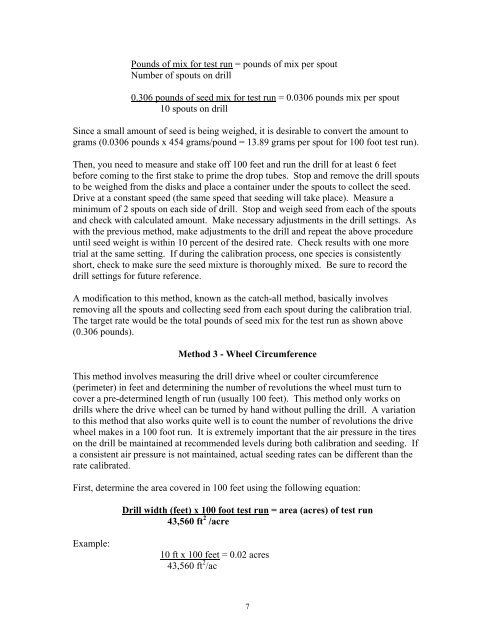TECHNICAL NOTE - Plant Materials Program
TECHNICAL NOTE - Plant Materials Program
TECHNICAL NOTE - Plant Materials Program
Create successful ePaper yourself
Turn your PDF publications into a flip-book with our unique Google optimized e-Paper software.
Pounds of mix for test run = pounds of mix per spout<br />
Number of spouts on drill<br />
0.306 pounds of seed mix for test run = 0.0306 pounds mix per spout<br />
10 spouts on drill<br />
Since a small amount of seed is being weighed, it is desirable to convert the amount to<br />
grams (0.0306 pounds x 454 grams/pound = 13.89 grams per spout for 100 foot test run).<br />
Then, you need to measure and stake off 100 feet and run the drill for at least 6 feet<br />
before coming to the first stake to prime the drop tubes. Stop and remove the drill spouts<br />
to be weighed from the disks and place a container under the spouts to collect the seed.<br />
Drive at a constant speed (the same speed that seeding will take place). Measure a<br />
minimum of 2 spouts on each side of drill. Stop and weigh seed from each of the spouts<br />
and check with calculated amount. Make necessary adjustments in the drill settings. As<br />
with the previous method, make adjustments to the drill and repeat the above procedure<br />
until seed weight is within 10 percent of the desired rate. Check results with one more<br />
trial at the same setting. If during the calibration process, one species is consistently<br />
short, check to make sure the seed mixture is thoroughly mixed. Be sure to record the<br />
drill settings for future reference.<br />
A modification to this method, known as the catch-all method, basically involves<br />
removing all the spouts and collecting seed from each spout during the calibration trial.<br />
The target rate would be the total pounds of seed mix for the test run as shown above<br />
(0.306 pounds).<br />
Method 3 - Wheel Circumference<br />
This method involves measuring the drill drive wheel or coulter circumference<br />
(perimeter) in feet and determining the number of revolutions the wheel must turn to<br />
cover a pre-determined length of run (usually 100 feet). This method only works on<br />
drills where the drive wheel can be turned by hand without pulling the drill. A variation<br />
to this method that also works quite well is to count the number of revolutions the drive<br />
wheel makes in a 100 foot run. It is extremely important that the air pressure in the tires<br />
on the drill be maintained at recommended levels during both calibration and seeding. If<br />
a consistent air pressure is not maintained, actual seeding rates can be different than the<br />
rate calibrated.<br />
First, determine the area covered in 100 feet using the following equation:<br />
Example:<br />
Drill width (feet) x 100 foot test run = area (acres) of test run<br />
43,560 ft 2 /acre<br />
10 ft x 100 feet = 0.02 acres<br />
43,560 ft 2 /ac<br />
7

















